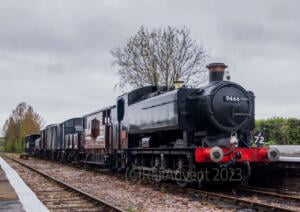On Saturday June 15th, the railway made history by deploying no less than five of its heritage diesels for passenger services.
Fans from across the country flocked to the Lincolnshire Coast Light Railway (LCLR) to see all nine of its Simplex diesel locomotives in a cavalcade, the major attraction of Diesel Day.
Built in 1920, “Nocton” is the oldest locomotive. The “youngest” “Fred” (which had survived inundation in the East Coast Floods at Mablethorpe in 1953), dates from 1947 and finished its working life at Skegness Brickworks. Motor Rail Ltd. of Bedford originally built theses Simplex engines.
The design of these engines originated in the trenches of World War 1, where light railways were an effective way (sometimes the only way) of transporting supplies, ammunition and men to the front over treacherous shell-holed and muddy terrain.
They proved so rugged and reliable that after the war, Motor Rail adapted and modified them over the years, using the brand name “Simplex”.

Even in 2024, they are proving just as reliable, sturdy and useful, after use in mining and agricultural roles for over 70 years.
The basic design, with some modifications, continued to be built until after the Second World War.
Their usefulness was especially evident in Lincolnshire, where they transported various heavy loads such as potatoes, sugar beet, fertiliser, clay, bricks, timber, and even holidaymakers.
However, they became redundant with the improvement of roads and road vehicles.
By carefully devised combinations with the other, air-braked, locomotives normally used on timetabled passenger services, it was possible for passengers to enjoy a ride on trains powered by five of the railway’s stars:
- “#6” – a 1941 Simplex
- “Fred”
- “Sark” – a 40 horsepower, air-cooled Simplex normally used for shunting.
- A privately owned Simplex (builder’s number # 8905) which had only fired up its replacement engine one week earlier.
- “T3” – a 1942-built Simplex, now fitted with an air-cooled engine, which has recently undergone a major overhaul on the LCLR.

We spoke to visitors who told us they had travelled from as far as Kent, Windsor, Gloucestershire, the Ffestiniog Railway, Manchester and Preston, as well as the East Midlands and Yorkshire, to participate.
“It’s clearly a highly specialised area of interest within the wider range of enthusiasms for railways, but everyone seemed to think it well worth the journey to Skegness to participate and we are very grateful for their support.
Richard Shepherd, Chairman of the LCLR’s supporting Historic Vehicles Trust






Responses